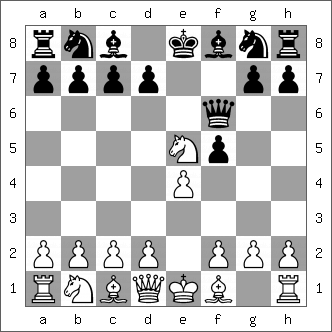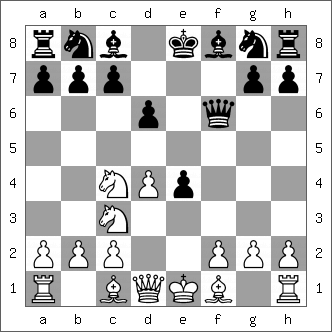Some time ago, for fun, I examined the Latvian Gambit from Black's point of view. For chesstalk purposes I'll put forward a small number of variations that may or may not prove critical to any effort to rehabilitate this defence. I'll grant that theory may have little trouble arguing for a slight positional advantage for White in this opening, but most people seem to believe that Black should do far worse than that. Anyone who has specialist material on the Latvian, unlike me, can feel free to comment.
After the moves
1.e4 e5 2.Nf3 f5!?

White's most popular option is undoubtedly
3.Nxe5

and after the usual
3...Qf6

White has two options:
A. 4.d4

Play continues 4...d6 5.Nc4 fxe4

when the main line starts with 6.Nc3

Now there are two possibilities I'd like to look at.
A1. 6...Qg6 (the main line, all that ECO gives; the problem for Black, if he wishes to win, is that the final position of this line looks rather short on winning chances for him)

7.f3 (again the main line in ECO) 7...exf3 8.Qxf3

8...Nf6 (It would be nice if 8...Nc6 was playable, but ECO's quite lengthy analysis, showing it leads to a big advantage for White after 9.Nb5!, is quite convincing)
9.Bd3 Qf7 10.0-0 Be7 11.Ne3

L. Guidarelli-Le Roux, France (ch). White has a slight edge according to ECO. It seems to me Black has few winning chances, especially if White is unambitious.
A2. 6...Bf5 (I think this may be Black's best move, at least if he is trying to win; what follows is my own short analysis of two of White's most interesting replies)

A21. 7.Ne3

7...Bg6?!
Better is 7...c6 or 7...Ne7, when Black doesn't appear to be much worse.
8.Ned5

Now Black is in trouble, since 8...Qf7 is answered by 9.Bc4!
A22. 7.g4

7...Bg6 8.Bg2

Here Black has three options that could be researched further:
A221. 8...c6

Now, even in case of 9.d5 b5, Black's game may be playable.
A222. 8...Na6

Here the following continuation is possible:
9.Nxe4 Qf7 10.Qe2 0-0-0 11.Ng5 Qd7 12.Bd5 Kb8

Again, this may be playable for Black.
A223. 8...Nc6

This looks like Black's most sober option. The following continuation needs examination:
9.d5 Ne5 10.Nxe5 dxe5!

B. 4.Nc4

This move holds pride of place in ECO, which holds that it is the way for White to gain a big advantage. There are two continuations that may be interest here for Black, the usual 4...fxe4 (which I leave out at least for now, for reasons of space), and the more rare
4...b5!?

This move is left out of the latest (5th) edition of ECO. In the previous edition the following was offered in a footnote:
5.e5 Qe6 6.Qf3 bxc4 7.Qxa8 Qxe5+ 8.Kd1 c6 9.Qxa7 Bc5 10.Qa4

Now ECO's note ends 10...Bxf2 11.Bxc4 with a big edge for White, P. Toloza-J. Cueto, Santiago 1997. Instead Fritz suggests
10...Nf6!?

and after 11.f3 (not 11.Bxc4? Ne4) 11...d5 12.Bxc4 0-0

Black at least has some compensation, in my estimation.
After the moves
1.e4 e5 2.Nf3 f5!?
White's most popular option is undoubtedly
3.Nxe5
and after the usual
3...Qf6
White has two options:
A. 4.d4
Play continues 4...d6 5.Nc4 fxe4
when the main line starts with 6.Nc3
Now there are two possibilities I'd like to look at.
A1. 6...Qg6 (the main line, all that ECO gives; the problem for Black, if he wishes to win, is that the final position of this line looks rather short on winning chances for him)
7.f3 (again the main line in ECO) 7...exf3 8.Qxf3
8...Nf6 (It would be nice if 8...Nc6 was playable, but ECO's quite lengthy analysis, showing it leads to a big advantage for White after 9.Nb5!, is quite convincing)
9.Bd3 Qf7 10.0-0 Be7 11.Ne3
L. Guidarelli-Le Roux, France (ch). White has a slight edge according to ECO. It seems to me Black has few winning chances, especially if White is unambitious.
A2. 6...Bf5 (I think this may be Black's best move, at least if he is trying to win; what follows is my own short analysis of two of White's most interesting replies)
A21. 7.Ne3
7...Bg6?!
Better is 7...c6 or 7...Ne7, when Black doesn't appear to be much worse.
8.Ned5
Now Black is in trouble, since 8...Qf7 is answered by 9.Bc4!
A22. 7.g4
7...Bg6 8.Bg2
Here Black has three options that could be researched further:
A221. 8...c6
Now, even in case of 9.d5 b5, Black's game may be playable.
A222. 8...Na6
Here the following continuation is possible:
9.Nxe4 Qf7 10.Qe2 0-0-0 11.Ng5 Qd7 12.Bd5 Kb8
Again, this may be playable for Black.
A223. 8...Nc6
This looks like Black's most sober option. The following continuation needs examination:
9.d5 Ne5 10.Nxe5 dxe5!
B. 4.Nc4
This move holds pride of place in ECO, which holds that it is the way for White to gain a big advantage. There are two continuations that may be interest here for Black, the usual 4...fxe4 (which I leave out at least for now, for reasons of space), and the more rare
4...b5!?
This move is left out of the latest (5th) edition of ECO. In the previous edition the following was offered in a footnote:
5.e5 Qe6 6.Qf3 bxc4 7.Qxa8 Qxe5+ 8.Kd1 c6 9.Qxa7 Bc5 10.Qa4
Now ECO's note ends 10...Bxf2 11.Bxc4 with a big edge for White, P. Toloza-J. Cueto, Santiago 1997. Instead Fritz suggests
10...Nf6!?
and after 11.f3 (not 11.Bxc4? Ne4) 11...d5 12.Bxc4 0-0
Black at least has some compensation, in my estimation.


 .
.
Comment